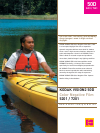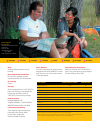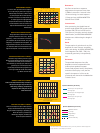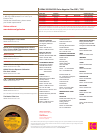
Daylight (5500 K) None 50
Tungsten (3000 K) WRATTEN Gelatin No. 80A 12
Tungsten (3200 K) WRATTEN Gelatin No. 80A 12
Tungsten Photoflood (3400 K) WRATTEN Gelatin No. 80A 12
White-Flame Arcs Color Compensating Filter 20C + 40Y 32
Yellow-Flame Arcs Color Compensating Filter 40C 12
OPTIMA 32 WRATTEN Gelatin No. 80A 12
VITALITE None 50
Fluorescent, Cool White† Color Compensating Filter 10M + 05B 32
Fluorescent, Deluxe Cool White† WRATTEN Gelatin No. 10B + 20C 32
Metal Halide H.M.I. None 50
*These are approximate corrections only. Make final corrections during printing.
†These are starting-point recommendations for trial exposures. If the type of fluorescent lamp is unknown,
use a KODAK Color Compensating Filter CC20M with an exposure index (EI) of 32.
LIGHT SOURCE
KODAK
FILTERS ON CAMERA* EXPOSURE INDEX
Base
Acetate safety base with rem-jet
backing.
Darkroom Recommendations
Do not use a safelight. Handle
unprocessed film in total darkness.
Processing
ECN-2
Storage
Store unexposed film at 13°C (55°F) or
lower. For storage of
unexposed
film
longer than 6 months, store at
-18°C (0°F). Process film promptly.
Exposure Index
Daylight (5500 K)—50;
Tungsten (3200 K)—12 (with KODAK
WRATTEN Gelatin Filter No. 80A).
Laboratory Aim Density
Time negative originals relative to
Laboratory Aim Density (LAD)
Control Film supplied by
Eastman Kodak Company.
Color Balance
This film is balanced for exposure with
daylight illumination (5500 K). For other
light sources, use the correction filters
in the table below.
Postproduction information
When you transfer this film directly to
video, set up the telecine using negative
Telecine Analysis Film (TAF).
1
2
4
5
6
7
8
Original Negative
E
XPOSURE DATA
Lens: 85 mm Zeiss Ultra Prime
Filter:Clear
Aperture: T5.6
Incident Light Levels
Key = 800 fc
Color temperature = 5460 K
3
5
4
-0.5 Stops
1
-2.6 Stops
2
-1.5 Stops
3
-1.0 Stops
4
0 Stops
5
+0.3 Stops
6
+0.4 Stops
7
+2.3 Stops
8






